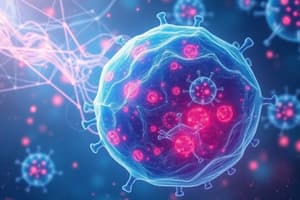Podcast
Questions and Answers
Which of the following best describes type III hypersensitivity reactions?
Which of the following best describes type III hypersensitivity reactions?
- Results in IgE mediated release of histamines.
- Primarily causes immediate hypersensitivity responses.
- Involves the formation of antigen-antibody complexes. (correct)
- Directly damages cells without forming complexes.
What is a common target tissue affected by type III hypersensitivity?
What is a common target tissue affected by type III hypersensitivity?
- Kidneys (correct)
- Liver
- Muscle tissue
- Nervous tissue
What happens to the antigen-antibody complexes in type III hypersensitivity reactions?
What happens to the antigen-antibody complexes in type III hypersensitivity reactions?
- They trigger anaphylactic shock.
- They are deposited in tissues and cause damage. (correct)
- They dissolve completely in circulation.
- They are exclusively eliminated by macrophages.
Which of the following can initiate a type III hypersensitivity reaction?
Which of the following can initiate a type III hypersensitivity reaction?
What role do neutrophils play in type III hypersensitivity reactions?
What role do neutrophils play in type III hypersensitivity reactions?
The Arthus reaction is characterized by which of the following?
The Arthus reaction is characterized by which of the following?
Which of these antigens is commonly associated with type III hypersensitivity?
Which of these antigens is commonly associated with type III hypersensitivity?
Complement proteins in type III hypersensitivity reactions are activated to:
Complement proteins in type III hypersensitivity reactions are activated to:
What results from the recognition of self-antigen by mature T lymphocytes?
What results from the recognition of self-antigen by mature T lymphocytes?
Which statement accurately describes the role of antigen presenting cells (APCs) in peripheral T lymphocyte tolerance?
Which statement accurately describes the role of antigen presenting cells (APCs) in peripheral T lymphocyte tolerance?
How does the reduction in CD4 Th cell population affect the immune response?
How does the reduction in CD4 Th cell population affect the immune response?
What is the approximate number of bacteria and viruses present in the human body?
What is the approximate number of bacteria and viruses present in the human body?
What role do Treg cells play in the immune response to commensal microbes?
What role do Treg cells play in the immune response to commensal microbes?
What is the main characteristic of autoimmune diseases?
What is the main characteristic of autoimmune diseases?
In the context of peripheral B lymphocyte tolerance, what happens when mature B lymphocytes recognize self-antigen?
In the context of peripheral B lymphocyte tolerance, what happens when mature B lymphocytes recognize self-antigen?
What best describes the generation of central tolerance?
What best describes the generation of central tolerance?
What is the primary immune response involved in Type I hypersensitivity reactions?
What is the primary immune response involved in Type I hypersensitivity reactions?
Which cytokine is not produced by Th2 cells during a Type I hypersensitivity reaction?
Which cytokine is not produced by Th2 cells during a Type I hypersensitivity reaction?
What is a consequence of mast cell activation in Type I hypersensitivity reactions?
What is a consequence of mast cell activation in Type I hypersensitivity reactions?
In Type II hypersensitivity, which mechanism is involved in the destruction of target cells?
In Type II hypersensitivity, which mechanism is involved in the destruction of target cells?
Which of the following is NOT a clinical consequence of Type I hypersensitivity reactions?
Which of the following is NOT a clinical consequence of Type I hypersensitivity reactions?
What type of cells are primarily recruited during a Type I hypersensitivity reaction?
What type of cells are primarily recruited during a Type I hypersensitivity reaction?
Which factor is most directly responsible for the itching sensation in allergic reactions?
Which factor is most directly responsible for the itching sensation in allergic reactions?
What role do dendritic cells play in Type I hypersensitivity reactions?
What role do dendritic cells play in Type I hypersensitivity reactions?
In Type II hypersensitivity, which of the following is a common antigenic target?
In Type II hypersensitivity, which of the following is a common antigenic target?
Which of the following diseases is associated with Type III hypersensitivity reactions?
Which of the following diseases is associated with Type III hypersensitivity reactions?
What mediates the lysis of target cells in Type II hypersensitivity reactions?
What mediates the lysis of target cells in Type II hypersensitivity reactions?
What mediates Type IV hypersensitivity reactions?
What mediates Type IV hypersensitivity reactions?
Which of the following is NOT a characteristic of Type IV hypersensitivity reactions?
Which of the following is NOT a characteristic of Type IV hypersensitivity reactions?
In Type IV hypersensitivity reactions, what happens to target cells?
In Type IV hypersensitivity reactions, what happens to target cells?
What role do susceptibility genes play in autoimmune diseases like Systemic Lupus Erythematosus (SLE)?
What role do susceptibility genes play in autoimmune diseases like Systemic Lupus Erythematosus (SLE)?
Which condition is an example of a delayed hypersensitivity reaction?
Which condition is an example of a delayed hypersensitivity reaction?
What type of immune complexes are implicated in Raynaud disease?
What type of immune complexes are implicated in Raynaud disease?
Which environmental factor is a known trigger for autoimmune diseases?
Which environmental factor is a known trigger for autoimmune diseases?
How do sensitized T-lymphocytes contribute to tissue graft rejection?
How do sensitized T-lymphocytes contribute to tissue graft rejection?
In Systemic Lupus Erythematosus (SLE), which organs can be affected by the disease?
In Systemic Lupus Erythematosus (SLE), which organs can be affected by the disease?
What characterizes the pathophysiology of Type IV hypersensitivity reactions?
What characterizes the pathophysiology of Type IV hypersensitivity reactions?
What is a significant aspect of the epidemiology of Systemic Lupus Erythematosus (SLE)?
What is a significant aspect of the epidemiology of Systemic Lupus Erythematosus (SLE)?
Which statement best represents the interaction of genetic predispositions and environmental triggers in SLE?
Which statement best represents the interaction of genetic predispositions and environmental triggers in SLE?
Which hypersensitivity reaction is particularly involved in the progression of Systemic Lupus Erythematosus?
Which hypersensitivity reaction is particularly involved in the progression of Systemic Lupus Erythematosus?
What are some of the clinical manifestations of Systemic Lupus Erythematosus?
What are some of the clinical manifestations of Systemic Lupus Erythematosus?
What is a challenge in diagnosing Systemic Lupus Erythematosus?
What is a challenge in diagnosing Systemic Lupus Erythematosus?
Study Notes
Hypersensitivity Reactions Overview
- Hypersensitivity reactions are exaggerated immune responses that can result in inflammation and damage to various tissues or organs, potentially manifesting as a range of clinical symptoms. These reactions occur when the immune system becomes overly sensitive to substances that are typically harmless, known as allergens.
- There are four principal types of hypersensitivity reactions: Type I (Immediate), Type II (Cytotoxic), Type III (Immune Complex), and Type IV (Delayed). Each type is characterized by distinct mechanisms and clinical outcomes, involving different components of the immune system.
Type I Hypersensitivity Reactions
- Type I hypersensitivity reactions are primarily mediated by Immunoglobulin E (IgE) antibodies that react against specific allergens. These allergic responses often occur within minutes of exposure to the allergen, hence the term "immediate." Exposure can occur through various routes, such as inhalation, ingestion, or direct contact.
- Key cytokines involved in this process include Interleukin-4 (IL-4) and Interleukin-5 (IL-5), which play critical roles in stimulating the production of IgE and promoting the maturation of B lymphocytes into IgE-secreting plasma cells. This cytokine signaling is pivotal for the development and enhancement of allergic responses.
- Once IgE is produced, it binds to high-affinity IgE receptors (FcεRI) on the surface of mast cells. Subsequent exposure to the same allergen leads to the cross-linking of IgE on mast cells, causing them to degranulate. This process releases a variety of mediators including histamine, leukotrienes, and prostaglandins, which contribute to the allergic symptoms experienced by the individual.
- Clinical manifestations of Type I hypersensitivity range from localized allergic reactions such as itching, urticaria (hives), and allergic rhinitis to more severe systemic responses such as anaphylaxis. Anaphylaxis is a life-threatening allergic reaction characterized by symptoms such as difficulty breathing, swelling of the throat, rapid drop in blood pressure, and potential loss of consciousness, necessitating immediate medical intervention.
Type II Hypersensitivity Reactions
- Type II hypersensitivity reactions are characterized by the destruction of target cells through the binding of antibodies to specific antigens located on the surface of these cells. This binding triggers various pathogenic mechanisms that ultimately lead to cell lysis or functional impairment.
- Common target antigens in Type II reactions include human leukocyte antigens (HLA), tissue-specific antigens, and some drugs and their metabolites. These antigens can be derived from autoimmune processes or can result from the introduction of foreign substances (like transfused blood) that mimic human antigens.
- Pathophysiological mechanisms for Type II hypersensitivity include:
- Complement-mediated lysis: The classical complement pathway may be activated by antibody-antigen complexes, leading to the formation of the membrane attack complex, resulting in the lysis of the target cell.
- Phagocytosis by macrophages: Antibody-coated cells may be recognized by phagocytes, which ingest and destroy the target cells.
- Antibody-dependent cell-mediated cytotoxicity (ADCC): Natural killer (NK) cells can recognize and kill antibody-bound target cells, contributing to the cell's destruction.
Type III Hypersensitivity Reactions
- Type III hypersensitivity reactions are a result of immune complex formation, where antigen-antibody complexes form in circulation and subsequently deposit in various tissues. This accumulation triggers an inflammatory response that can lead to significant tissue damage.
- Common antigens involved in Type III reactions include those derived from viral, bacterial, and parasitic infections, as well as environmental factors such as pollen or autoantigens from self-tissues. The formation of these immune complexes can occur after the presence of infections or as a result of autoimmunity.
- Pathophysiology of Type III reactions typically involves:
- Immune complexes deposit in tissues such as the kidneys and blood
Studying That Suits You
Use AI to generate personalized quizzes and flashcards to suit your learning preferences.
Related Documents
Description
This quiz focuses on the pathophysiology of Type I hypersensitivity reactions, including the roles of dendritic cells, Th2 cells, and cytokines. Understand the immune responses involved in allergen presentation and IgE production. Test your knowledge about the mechanisms underlying hypersensitivity reactions.




